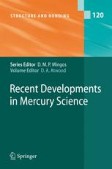Search
Search Results
-
Heat transfer characteristics of cascade phase change energy storage composite pipeline
In the context of dual-carbon strategy, the insulation performance of the gathering and transportation pipeline affects the safety gathering and...

-
Carbene Complexes of Heme Proteins and Iron Porphyrin Models
The possible formation of carbene complexes of cytochromes P450 enzymes in various metabolisms of xenobiotics is first described. In view of these...
-
Ferrocene–Peptide Bioconjugates
This chapter sketches an outline of ferrocene–peptide bioconjugates. A variety of ferrocene–peptide bioconjugates have been designed to induce...
-
Catalytic Nickel–Iron–Sulfur Clusters: From Minerals to Enzymes
The geochemical theory of the origin of life proposes that primordial, pre-biotic reactions were carried out in a metal-sulfide-rich environment...
-
Sequentially Palladium-Catalyzed Processes
Sequentially palladium-catalyzed reactions consist of combinations of identical, related, or significantly different palladium-catalyzed processes...
-
Structural Aspects of Layered Double Hydroxides
Layered double hydroxides (LDHs) have been known for a considerable time and have been widely studied. The basic features of their structure,...
-
n-Body Decomposition Approach to the Calculation of Interaction Energies of Water Clusters
A new methodology is proposed in which large basis set MP2-level calculations can be extended to water clusters with as many as 50 monomers. The...
-
Multiporphyrin ArraysAssembled Through Hydrogen Bonding
Although relatively weak in isolation, composite H-bonds can be used as an advantage for the assembly of relatively robust and well-defined arrays...
-
Axial Coordination to Metalloporphyrins Leading to Multinuclear Assemblies
The use of axial coordination to metalloporphyrins is discussed on the basis of constructing multinuclear complexes. Starting with single...
-
Poly(mercaptoimidazolyl)borate Complexes of Cadmium and Mercury
The coordination chemistry of bis- and tris(mercaptoimidazolyl)borate ligands with both main-group and transition metals is rapidly expanding....
-
Mercury Removal from Water
Mercury pollution in water is a serious threat to natural ecosystems. Various methods and technologies are in use to remove mercury from the...
-
Intermolecular Interactions via Perturbation Theory: From Diatoms to Biomolecules
This article is devoted to the most recent, i.e. taking place within the last few years, theoretical developments in the field of intermolecular...
-
Hydrogels for Musculoskeletal Tissue Engineering
The advancements in scaffold-supported cell therapy for musculoskeletal tissue engineering have been truly dramatic in the last couple of decades....
-
Polymer Therapeutics for Cancer: Current Status and Future Challenges
Drug delivery systems for cancer therapeutics have revolutionized medicine. Delivery systems have improved the efficacy and reduced the toxicity of...
-
Nanostructured Devices Based on Block Copolymer Assemblies for Drug Delivery: Designing Structures for Enhanced Drug Function
Block copolymers spontaneously assemble into nanoscaled polymeric micelles, which have significant potential as drug carriers. Following much work...
-
Towards a Rational Design of Molecular Switches and Sensors from their Basic Building Blocks
A fundamental understanding of the thermodynamics and kinetics of mechanically interlocked molecules, such as [2]rotaxanes, will contribute to...
-
Tin-Free Radical Reactions Mediated by Organoboron Compounds
The development of tin-free methods to run radical reactions is crucial for their applications in industrial processes as well as in drug...
-
Immobilization of Oligonucleotides for Biochemical Sensing by Self-Assembled Monolayers: Thiol-Organic Bonding on Gold and Silanization on Silica Surfaces
The covalent immobilization of biomolecules on surfaces is of great interest for many medical and bioanalytical applications. Currently, there is...
-
Immobilization of Nucleic Acids Using Biotin-Strept(avidin) Systems
There are several advantages for using biotin-streptavidin/avidin (strept(avi-din)) systems to immobilize nucleic acids and other molecules. These...
-
Immobilization of DNA on Microarrays
Microarrays are new analytical devices that allow the parallel and simultaneous detection of thousands of target compounds. Microarrays, also...
